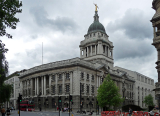
As we prepare for COP 26, the expansion of the world-leading Ultra Low Emission Zone, a new Environment Bill and new targets set by the World Health Organization
for toxic air, the Mayor of London, Sadiq Khan, has today warned time is running out to meet the goals of the Paris Agreement and to tackle the climate emergency before it’s too late.
COP26 will be a critical moment for the UK to show its climate leadership. The agreement that nations from around the world reach in Glasgow this November will determine whether we are going to avert the worst consequences of climate change, which could be devastating for London.
Sadiq will make a keynote speech today spelling out why the climate emergency remains one of the biggest threats London and the world faces. Average temperatures around the world, including in London, are already increasing. This summer, we saw the impact of the climate emergency first-hand with soaring temperatures and flash floods in London.
Climate Vulnerability Mapping produced City Hall and Bloomberg Associates, Bloomberg Philanthropies’ pro-bono consultancy for cities, shows that six London boroughs are at particularly high risk from the effects of climate change, with most boroughs, particularly in inner London, showing at least some high risk.
The boroughs at particularly high risk, meaning that the risk of both flooding and overheating are very high, jeopardising lives and livelihoods are:
- Hackney
- Hammersmith and Fulham
- Islington
- Brent
- Tower Hamlets
- Newham
More generally, City Hall analysis has identified that:
- a quarter of London’s rail stations, and 10 per cent of London’s rail network, are at high risk of flooding in the future if extreme temperatures and flooding get worse.
- 1 in 5 of our schools are either totally or partially at risk of flooding and nearly half of our hospitals.
- there are over 200,000 existing homes and workplaces in London that are at either high or medium risk of surface water flooding alone.
- all school children in London attend schools with toxic air based on the latest WHO guidelines issued yesterday.
A study led by University of Oxford, found that external air temperatures of 27 degrees and above ground will make it uncomfortably hot for passengers on the Tube network. In the worst case scenario, there would be 8 days (baseline period – 1961-1990) where external temperatures exceed 27 degrees, compared to up to 29 days by 2030 and 41 days by 2050.*
In London, the Mayor has already taken action through the introduction of the world’s first Ultra Low Emission Zone, which has helped reduce pollution in central London by nearly half at the same time as helping to reduce carbon emissions. On 25 October, the zone will expand up to the north and south circular, taking in 3.8 million Londoners, and is expected to reduce road transport NOx emissions by around 30 per cent. The Mayor has also: planted 340,000 trees since 2016; introduced over 500 zero emission buses; committed to making London a zero-carbon city by 2030, faster than any comparable city; developed a climate action plan that is compatible with the highest ambition of the Paris Agreement.
Through his London Plan the Mayor has achieved carbon emission reductions of almost 50 per cent more than set by building regulations. This was set out in his London Plan Energy Monitoring Report 2020, released today, which shows that his planning policies are achieving on-site carbon reduction resulting in a saving of 44,000 tonnes of carbon a year.
Today the Mayor also launches a London-wide environment campaign to inspire all Londoners – individuals, businesses and communities – to take action too. This is starting with an art installation by Julian Beever and supported by Bloomberg Philanthropies, at Prior Weston primary school symbolising the crossroads we currently face and that by making the right choices we can provide a greener, fairer future for younger generations.
Most important of all, the UK Government must realise that in order to achieve its own net zero target it must devolve powers and long-term funds to London and other Mayors and local authorities who will be delivering on the ground.
The Mayor of London, Sadiq Khan, said: “In the year of COP26, London is at a crossroads. We either take bold action now or face the consequences - with catastrophic impacts on our environment, the air we breathe and the climate.
“I’m determined for London to be a world leader in tackling the twin dangers of air pollution and the climate emergency so that we can deliver a brighter future for London - one that’s greener, fairer and more prosperous for everyone. That’s why I’ve committed to making London a zero-carbon city by 2030, faster than any comparable city, and it’s why we are delivering a climate action plan that is compatible with the highest ambition of the Paris Agreement. I also want London to be a zero-pollution city so that no child has to grow up in our city breathing toxic air. That’s why I’m expanding the Ultra Low Emission Zone next month.
“But I can’t do it all alone. That’s why today I’m launching my city-wide campaign to inspire all Londoners – individuals, businesses and communities - to take action. I also want to work with the Government to unlock the powers and funding needed to meet our targets, which will help deliver national targets too.”
Michael R. Bloomberg, founder of Bloomberg L.P. and Bloomberg Philanthropies and the UN Secretary-General’s Special Envoy for Climate Ambition and Solutions, said: “The latest data makes it clear that the global climate emergency requires bold local action. At Bloomberg Philanthropies, we are glad to support the Mayor of London's creative and promising efforts to capitalize on the power of data and art to increase support for public health and raise awareness of the urgent need to fight climate change. We’ve been strong supporters of the Mayor's determined efforts to continue improving London’s air quality and engage young people in his ambition to make London a zero-carbon city by 2030, and this new initiative builds on that work.”
Polly Billington, Chief Executive UK100 said: "I am really excited to be here today with the Mayor of London. From securing zero emission buses to working with the private sector on green energy, Sadiq Khan is demonstrating the ambition and delivery of local and regional government is key to achieving the place-based transition to Net Zero."
Jane Burston, Clean Air Fund’s Executive Director, said: “Without decisive action, the dual threats of climate change and air pollution will run out of control. The good news is that we can choose a different future. London is a beacon of progress and leadership when it comes to climate and clean air action, demonstrating globally that action starts at home.” Photo by Wikimedia commons.



































